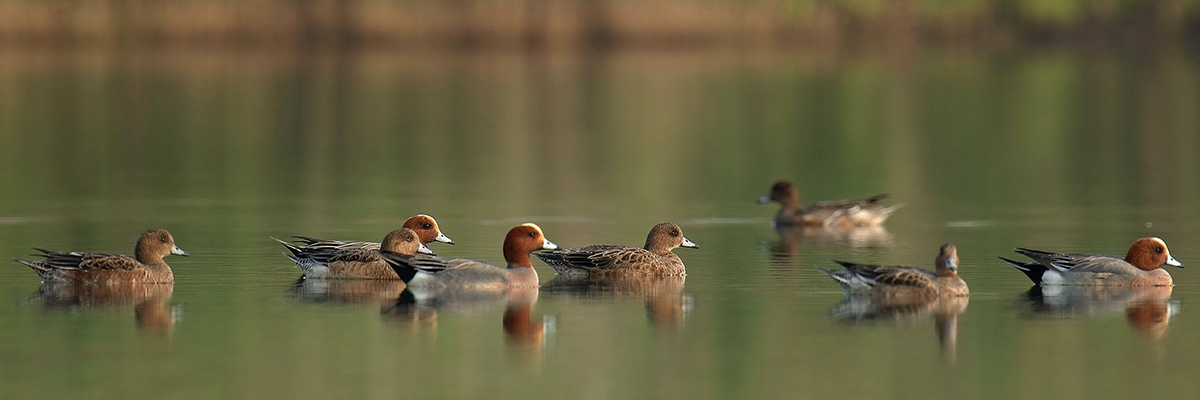

WORK OF THE CONSERVATION BRANCH
- To conserve local flora, fauna and natural habitats by offering professional advice on development proposals, planning strategies and environmental impact assessments;
- To draw up and implement biodiversity conservation plans, as well as to identify Sites of Special Scientific Interest (SSSI);
- To conduct regular ecological surveys, update inventories and manage an ecological database for Hong Kong;
- To control the release into the environment of genetically modified organisms, as well as their import and export;
- To monitor the ecology of the Mai Po Inner Deep Bay Ramsar Site and to develop and manage the Hong Kong Wetland Park;
- To protect endangered animal and plant species; and
- To promote public awareness of and participation in nature conservation through publicity and educational activities.
NATURAL ENVIRONMENT
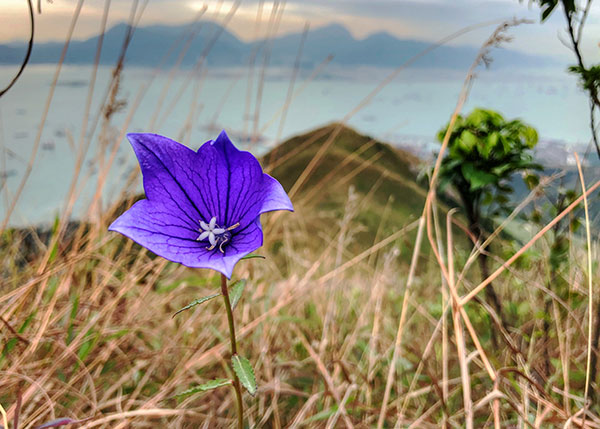
Hong Kong's topography and subtropical climate provide a wide range of habitats that support a rich variety of flora and fauna. Scenically, it has a great deal to offer – a landscape rising from sandy beaches and rocky foreshores to a height of almost 1
In Hong Kong, there are more than 3
BIODIVERSITY STRATEGY AND ACTION PLAN
The Government launched the Hong Kong Biodiversity Strategy and Action Plan (BSAP) (2016-2021) on December 21, 2016. Being the first city-level BSAP for Hong Kong, it sets out the strategy and action plan from 2016 to 2021 for conserving biodiversity and supporting sustainable development in Hong Kong, according to our own conditions and capabilities.
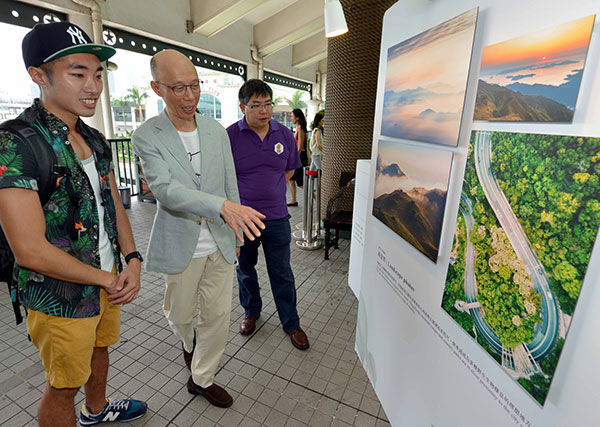
The BSAP sets out an action plan with 67 specific actions in four major areas: enhancing conservation measures, mainstreaming biodiversity, improving related knowledge and promoting community involvement. Under the BSAP, the Government will enhance existing measures and undertake new measures to conserve biodiversity, and continue to mainstream biodiversity within the Government. The Department will lead or commission studies on the action plan, and support funding applications for relevant research projects. To promote community involvement, a variety of education programmes were held during the year. A three-month Hong Kong Biodiversity Festival 2017 under the theme "Nature Around Us" was held with 40 partner organisations, offering more than 100 activities such as workshops, eco-tours, seminars and exhibitions, attracting over 125
In the past year, relevant Government bureaux and departments and other external stakeholders have also taken forward initiatives under their respective purviews. An Inter-departmental Working Group on BSAP chaired by the Secretary for the Environment has been established to oversee the implementation of the BSAP, monitor progress, coordinate efforts and facilitate mainstreaming of biodiversity.
ENHANCED NATURE CONSERVATION
Under the New Nature Conservation Policy announced in November 2004, 12 Priority Sites have been identified for enhanced conservation through Public-Private Partnership (PPP) and Management Agreement (MA) projects. In 2011, the MA Scheme was extended to cover country park enclaves and private land in country parks to further enhance conservation. The Department is responsible for monitoring the implementation of PPP and MA projects carried out by the private sector or non-governmental organisations in these sites.
As at March 2018, there were six MA projects implemented at four Priority Sites and two country park enclaves. The two MA projects commenced in Long Valley and Fung Yuen since 2005 covered around 20 hectares of private land. Two other MA projects in Ramsar Site and Deep Bay Wetland outside Ramsar Site, covering about 277 and 352 hectares of fishponds respectively, commenced in March 2017 to sustain the efforts in promoting conservation of fishponds in the Inner Deep Bay area. The MA projects at Sai Wan and Lai Chi Wo enclaves, both commenced in 2017, would rehabilitate around 5.5 hectares of private land and enhance their ecological value through collaborations with the local rural communities. The increase in the number and diversity of birds in Long Valley and butterflies in Fung Yuen as well as the increased abundance of waterbirds at fishponds during drain-down suggested that the MA scheme was effective in enhancing the conservation value of the sites. In addition to the direct benefit to biodiversity, the projects also raised the conservation awareness of the public, local residents and fish farmers.
ECOLOGICAL SURVEYS AND DATABASE
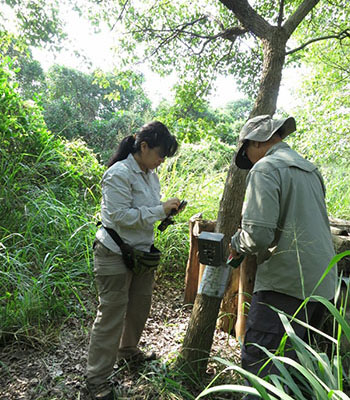
The Department has been conducting a territory-wide ecological survey programme since 2002 with a view to maintaining and updating an ecological database for Hong Kong. The survey programme covers major habitats of high conservation value in Hong Kong, as well as the distribution and abundance of selected animal groups. As at March 2018, over 311
The survey findings confirmed that Hong Kong has a rich biodiversity. The findings further indicated that a very significant portion of this biodiversity has been well preserved in our protected areas, where majority of the terrestrial and freshwater species regularly seen in Hong Kong can be found therein.
During the year, the Department continued to boost public interest in local biodiversity and arouse public awareness of nature conservation through its online database on representative species and habitats at Hong Kong Biodiversity Online and the Hong Kong Live Eco-map. Survey results and special findings are shared on our official website or through the Hong Kong Biodiversity newsletter, which is available online.
THE MAI PO INNER DEEP BAY RAMSAR SITE
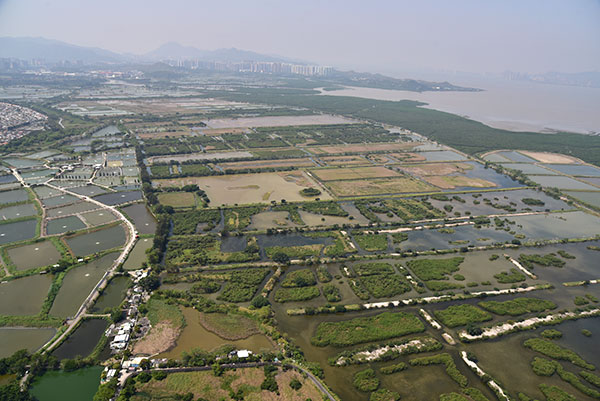
About 1
Since 2001, the Department has implemented a baseline ecological monitoring programme for the Ramsar Site. This long-term monitoring programme aims to collect ecological baseline information on the benthic communities and the condition of wetland habitats at the Ramsar Site.
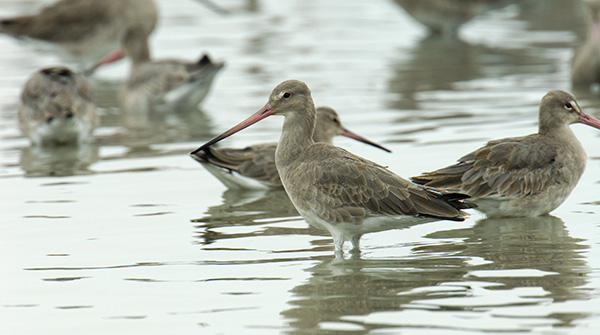
Commissioned by the Department, the Hong Kong Bird Watching Society has been carrying out a monthly waterbird monitoring programme for the Deep Bay area since 1997. From October 2017 to March 2018, the peak count of waterbirds at the Deep Bay in mid-winter was 60
BLACK-FACED SPOONBILLS
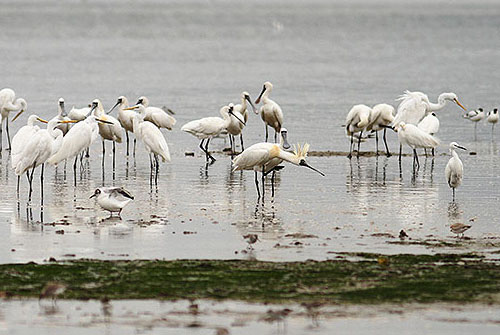
The Black-faced Spoonbill is a globally endangered species that can only be found in the East Asia region. In 2017-18 winter, the global population survey recorded 3
A conservation plan for Black-faced Spoonbills has been in place since 2001 which aims at maintaining the Mai Po Inner Deep Bay Ramsar Site in favourable conditions for the wintering Black-faced Spoonbills in Hong Kong. The plan also comprises measures for species and habitat protection and management, monitoring and research, education and training as well as regional cooperation.
SEA TURTLES
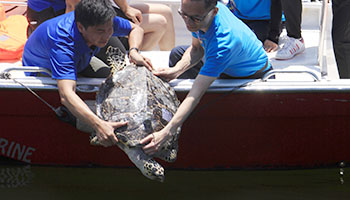
Green Turtle (Chelonia mydas) is the only sea turtle species that nests in Hong Kong from time to time. Various conservation measures have been put in place, including the designation of Sham Wan beach on Lamma Island as a Restricted Area during the nesting period of Green Turtles from June to October each year, regular patrols and public education about sea turtle conservation in Hong Kong. During the year, 7 seized or rescued Green Turtles were sent to Ocean Park Hong Kong for rehabilitation and to be released after recovery. With a view to tracking their movement and locating their foraging grounds, satellite transmitters will be attached to some of these turtles before release.
CONTROL OF TRADE IN ENDANGERED SPECIES
The Protection of Endangered Species of Animals and Plants Ordinance (Cap 586) gives effect to the Convention on International Trade in Endangered Species of Wild Fauna and Flora (CITES). It strictly regulates the trade in endangered species.
During the year, enforcement actions in combating illegal trade in endangered species were vigorously taken, resulting in 604 seizures that involved a variety of endangered species. The more commonly encountered specimens included live tortoises/turtles, red sandal wood, orchid, ivory, dried seahorse and pangolin carcass/scale.
To demonstrate the Government's commitment in combating the illegal ivory trade and to contribute to the global efforts in protecting wild elephants, the government submitted a bill to the Legislative Council in June 2017. The bill was passed in January 2018 as the Protection of Endangered Species of Animals and Plants (Amendment) Ordinance 2018 ("the Amendment Ordinance") . The Amendment Ordinance will take forward a three-step plan to enhance regulation on import and re-export of elephant ivory and elephant hunting trophies and eventually phase out the local ivory trade. It also imposes higher penalties to provide a stronger deterrent to the smuggling and illegal trading of endangered species.
Continuous efforts were made by the Department in educating the general public, students and traders to raise their awareness of protection of endangered species and compliance with relevant legislation. Such efforts include operating the Endangered Species Resource Centre, conducting talks in schools, holding roving exhibitions at public venues, distributing advisory leaflets as well as mounting displays at the airport and border control points and broadcasting TV and radio Announcements in the public interest.
Statistics on the control of trade in endangered species are at Appendix 12.
CONTROL OF GENETICALLY MODIFIED ORGANISMS
The Genetically Modified Organisms (Control of Release) Ordinance (the Ordinance) (Cap 607) gives effect to the Cartagena Protocol on Biosafety to the Convention on Biological Diversity. It controls the release into the environment, and the import and export, of genetically modified organisms (GMOs). Under the Ordinance, prior approval has to be sought from the Director of Agriculture, Fisheries and Conservation before a GMO could be released or imported into Hong Kong for release into the local environment. In addition, shipments containing GMOs, when being imported or exported, have to be accompanied with prescribed documents to enable easy identification of the GMOs and to provide the contact points for further information.
The Department has been collecting and testing market samples to monitor the availability of GMOs in local markets and farms since 2008.
The Department also launched a number of educational and publicity activities to enhance public awareness and understanding of the Ordinance, including distributing pamphlets to the general public and local farmers and updating survey results on GMOs and the online GMOs Register. Circular letters were also distributed to stakeholders to notify them of the latest news and information about the Ordinance.
THE HONG KONG WETLAND PARK
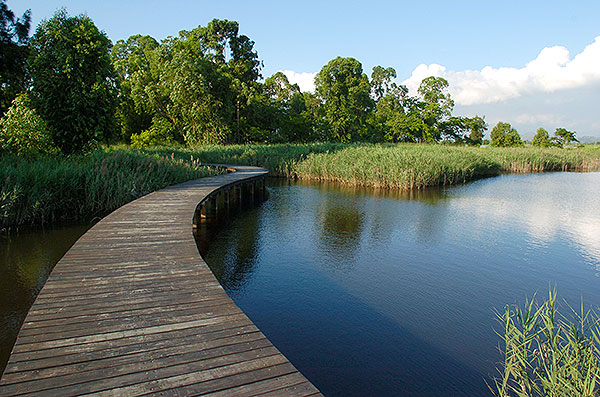
Opened in May 2006, the Hong Kong Wetland Park (HKWP) is a landmark in wetland conservation, with a mission to promote nature-based tourism in Hong Kong and foster public awareness of the values of wetlands. The Park combines the natural beauty of 60 hectares of wetland reserve with a visitor centre of over 10
In 2017-18, the Park organised a wide range of activities for some 185
The Park offered guided visit programmes to students from kindergartens to senior secondary schools. In 2017-18, the Park conducted around 840 guided tours for more than 21
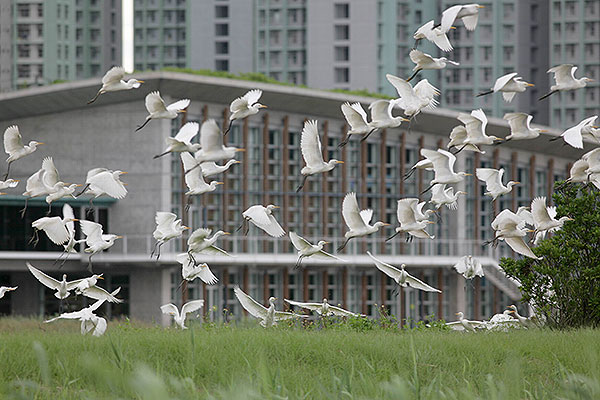
For the general public, the Park organised seven public lectures for around 360 visitors during the year. Various thematic events were organised to tie in with public holidays and major festivals, such as Bird Watching Festival, Where Wonders Begin: Our Nature, Festive Christmas at HKWP, Lunar New Year at HKWP, and Easter Wetland Unplugged Concert.
The Park continued to work with different sectors to promote the awareness of wetland conservation throughout the community. The Hong Kong Wetland Park Volunteer Scheme recruited around 780 volunteers in 2017-18. They assisted in the operation of the visitor centre and habitat management, and offered guided tours for visitors. The Park also established partnership programmes with non-governmental organisations to draw expertise and resources into the force of wetland conservation.
The Park plays an important role in promoting wetland conservation and education in the Asia Pacific region. Being an active player of the Wetland Link International – Asia network, the Park shares the best practices and experience in wetland education with wetland centres in the region.
Since 2003, the Department has been conducting habitat management at the Wetland Reserve inside the Park with a view to enhancing its ecological functions. The wetland habitats in the Wetland Reserve support Black-faced Spoonbill and many other waterbird species. The cumulative number of bird species recorded at the Reserve has reached 270. Waterbirds or birds dependent on wetlands make up approximately 45% of all species recorded. In addition to birds, ecological surveys conducted at the Reserve have recorded a variety of other species especially the wetland indicators – dragonflies, amphibians and reptiles. As at December 2017, the cumulative numbers of dragonfly, amphibian and reptile species recorded at the Reserve were 54, 10 and 31 respectively. This showed that, with proper site design and management, the objectives of nature conservation, education and tourism can co-exist.
HONG KONG HERBARIUM
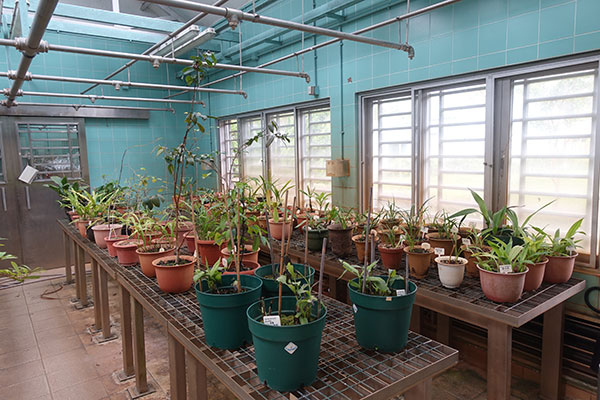
The Department manages the Hong Kong Herbarium which is responsible for the systematic collection, identification and maintenance of plant specimens of Hong Kong's flora. During the year, the specimen collection of the Herbarium exceeded 45
Following the publication of the English version of Flora of Hong Kong, the Hong Kong Herbarium collaborated again with the South China Botanical Garden in compiling the Chinese version of Flora of Hong Kong. The Chinese version will incorporate updates and revisions to the English version, as well as plant species newly recorded and species new to science. The first volume of the Chinese version of Flora of Hong Kong was published in December 2015, recording 22 species and varieties in 16 genera of 10 Gymnosperm families, and 615 species, varieties, subspecies and forms in 246 genera of 76 Angiosperms families of Magnoliopsida (Dicotyledons).
The Herbarium is functioning as a resource centre for plant workers for its collection of specimens, associated field notes and botanical literature offering good reference materials to botanists who wish to study about the local flora. In addition, the Herbarium aims to promote public awareness of local flora through organising guided visits, publishing educational materials and managing the "Hong Kong Plant Database" which provides basic information of more than 3
CONSERVATION OF RARE AND ENDANGERED FLORA
The Department's Field Investigation Unit (FIU) has adopted various methods such as seed collection, cutting, air-layering, etc, to propagate rare plants. Transplantation may also be carried out if habitats of rare or endangered plants are found to be under threat. Successful examples of active propagation include Keteleeria fortunei, Camellia crapnelliana and Camellia granthamiana. Seeds of these species have been collected in the field and seedlings raised in the Tai Tong Nursery of the Department. The seedlings have then been re-planted to the wild and populations successfully established.
The greenhouse of the FIU at the Tai Tong Nursery provides an excellent environment for conservation of rare and precious plants. The greenhouse is equipped with automatic misting, temperature and humidity control system as well as environmental growth chambers and seed depository. Around 100 local fragile species and seedlings, as well as orchids, are being kept in the greenhouse.
The Department has devised the Incense Tree Species Action Plan 2018-2022 to provide a pragmatic framework of conservation measures to achieve the long-term viability and sustainability of the local Incense Tree populations. Various actions will be undertaken through collaborations among different government departments, academic institutions, non-governmental organisations and local communities. The actions are to be taken from 2018 to 2022, and will be reviewed and refined once every five years.
SITES OF SPECIAL SCIENTIFIC INTEREST
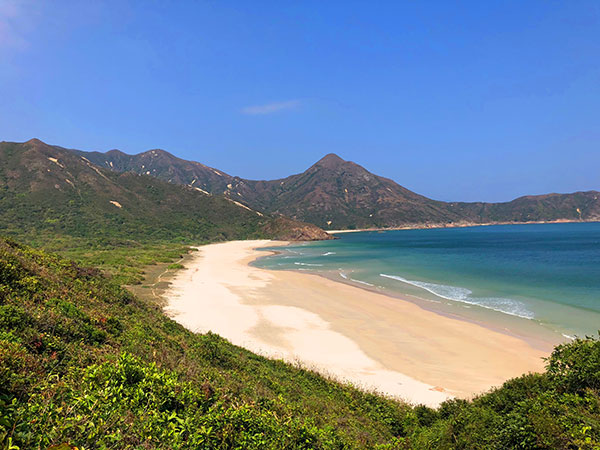
Sites of Special Scientific Interest (SSSIs) may be land-based or aquatic sites, which are of special scientific interest because of their flora, fauna, geological or physiographical features. Throughout the year, the Department continued to patrol and monitor the conditions and scientific values of all SSSIs. Where warranted, the Department also carried out appropriate habitat management work at some SSSIs to maintain or enhance their scientific value. For instance, Mikania control was conducted at Tai Om Fung Shui Woodland SSSI and She Shan Fung Shui Woodland SSSI to improve the growing condition for native species. The Department also continued to review the status of SSSIs and identify new sites suitable for SSSI listing or make proposals for de-listing those sites no longer deserving the SSSI status due to changes in circumstances over time after their listing. As at March 2018, there are 67 sites listed in the SSSI register.
MONKEYS
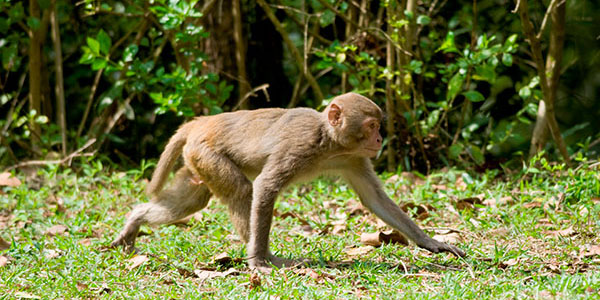
The monkey population in Hong Kong had increased in the past years and has caused public concern. To control the population increase in the long term, the Department has stepped up the field trial of contraceptive treatment. In 2017-18, the Department carried out such treatment on 117 monkeys. The Department also strengthened the enforcement of feeding ban in specific country parks to minimise monkey nuisance to visitors. During the year, 63 country park visitors were prosecuted for unauthorised feeding of monkeys. With the implementation of both the feeding ban and the contraceptive programme, it is observed that there is a decreasing trend in the population of monkeys.
WILD PIGS
Cases of wild pigs straying into the residential areas have been on the rise in recent years. In late 2017, the Department launched a two-year pilot scheme with a view to evaluating the effectiveness of a contraceptive vaccine for mammals on controlling the reproduction of wild pigs in the long term.
The most effective way to reduce the appearance of wild pigs in residential areas is the removal of food sources. Feeding will wrongly impress the wild animals that there is stable food supply and attract them to appear regularly near urban or residential areas. The Department had conducted a series of publicity and education programmes, including promotion on TV and radio, fun day, roving exhibitions, public lectures and visits, etc. to publicise the negative impacts of feeding wild animals. The Department has also set up a working group with relevant stakeholders and local experts to advise on the designs of litter bins and refuse collection points against wildlife's raids.